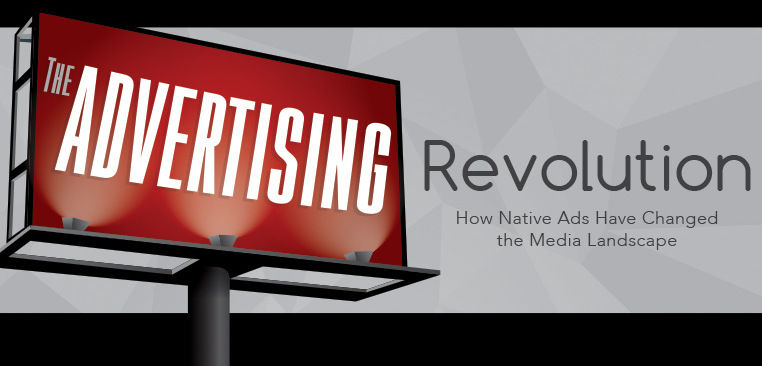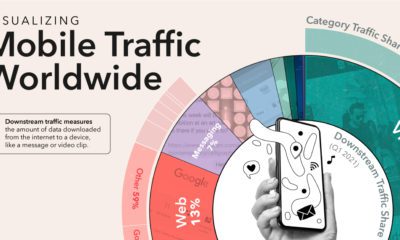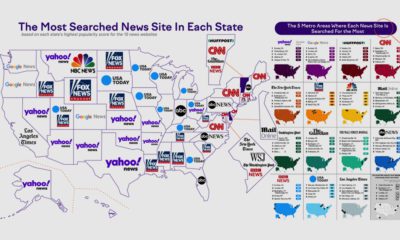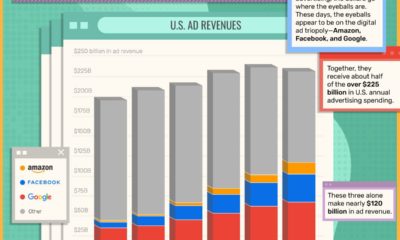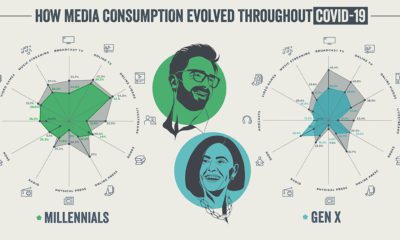Misc
The Advertising Revolution: How Native Ads Have Changed the Game

The Advertising Revolution
Sponsored by: Market One Media Group
Many decades ago, the world was much simpler for advertisers.
Buying a ½ page newspaper ad or a 30-second television spot reached thousands of people, and consumers weren’t oversaturated with ads.
Today, we are bombarded with over 5,000 brand exposures each day. Of those, 362 are advertisements with only 12 of them “making an impression” on us.
Here’s a breakdown of average exposure per day:
- Average number of advertisement and brand exposures per day per person: 5,000+
- Average number of “ads only” exposures per day: 362
- Average number of “ads only” noted per day: 153
- Average number of “ads only” that we have some awareness of per day: 86
- Average number of “ads only” that made an impression (engagement): 12
With this oversaturation of the traditional ad market, the concept of “native ads” has emerged.
Native Ads
Native advertising is paid content that is created to fit the same format as a publisher’s organic content. In other words, it shows up to regular viewers as “sponsored” or “paid” posts in the same streams as regular content.
Native ad spending has exploded, and from 2013 to 2018, the industry is expected to quadruple in size.
There are compelling statistics for both the audience and advertisers on native ads:
Audience:
- 70% of individuals want to learn about products or content through content rather than traditional advertising.
- 32% of consumers said, when given a choice, that they would rather share a native ad with friends and family vs 19% for banner ads.
- 57% of publishers have a dedicated editorial team to create content readers will care about, leaving publishers in full control, not brands, which ultimately benefits readers.
Advertisers:
- People view native ads 53% more than banner ads.
- Native advertising generates up to an 82% increase in brand lift.
- Native ads that include rich media boost conversion rates by up to 60%.
- Purchase intent is 53% higher with native ads (vs. 34%)
- 49x higher clickthrough rate, 54% lower cost-per-click
New Media
Native ads are also being used by many of the “new media” and adtech companies that have had very successful fundraising rounds:
Vice
Latest raise: $250 million (2014)
Led by: A+E Networks
Valuation: $2.5 billion
AppNexus
Latest raise: $62.7 million (2015)
Valuation: $1.2 billion
Vox
Latest raise: $200 million (2015)
Led by: NBC Universal
Valuation: $850 million
Buzzfeed
Latest raise: $200 million (2015)
Led by: NBC Universal
Valuation: $1.5 billion
The Future of Native Advertising?
Right now 41% of brands use native advertising as part of their marketing mix, but the shift is only beginning. Here’s what experts think the future of native holds:
Tessa Gould, Director of Native Ads Products, The Huffington Post
“Next for native is being able to use other ad technologies to make native smarter. At the moment everyone is creating content and talking about social actions. But how do you go about retargeting the people who view the native ad elsewhere with banner ads and actually converting them into customers?”
Audra Martin, VP of Advertising, The Economist Group
“As publishers start to educate brands more and agencies more, the content will just get better. Then distribution, in terms of getting more sophisticated, not in terms of fooling readers but making it relevant to readers in the right place at the right time.”
Steve Edwards, Digital Sales Director, Hearst UK
“My main thing is about control. Native will continue to develop along the lines it has. Increasingly it’s about publishers taking control of the message and advertisers and brands coming along with us. Getting distribution right and getting measurement metrics right, how we actually measure success. How we can create work that is as good as the editorial that surrounds it. Take the logo off it, does it still work? That’s really interesting for us, and we’ve still got a way to get there.”
Sebastian Tomich, VP of Advertising, The New York Times
“Brands are jumping into native because they feel like they should be.”
VC+
VC+: Get Our Key Takeaways From the IMF’s World Economic Outlook
A sneak preview of the exclusive VC+ Special Dispatch—your shortcut to understanding IMF’s World Economic Outlook report.

Have you read IMF’s latest World Economic Outlook yet? At a daunting 202 pages, we don’t blame you if it’s still on your to-do list.
But don’t worry, you don’t need to read the whole April release, because we’ve already done the hard work for you.
To save you time and effort, the Visual Capitalist team has compiled a visual analysis of everything you need to know from the report—and our upcoming VC+ Special Dispatch will be available exclusively to VC+ members on Thursday, April 25th.
If you’re not already subscribed to VC+, make sure you sign up now to receive the full analysis of the IMF report, and more (we release similar deep dives every week).
For now, here’s what VC+ members can expect to receive.
Your Shortcut to Understanding IMF’s World Economic Outlook
With long and short-term growth prospects declining for many countries around the world, this Special Dispatch offers a visual analysis of the key figures and takeaways from the IMF’s report including:
- The global decline in economic growth forecasts
- Real GDP growth and inflation forecasts for major nations in 2024
- When interest rate cuts will happen and interest rate forecasts
- How debt-to-GDP ratios have changed since 2000
- And much more!
Get the Full Breakdown in the Next VC+ Special Dispatch
VC+ members will receive the full Special Dispatch on Thursday, April 25th.
Make sure you join VC+ now to receive exclusive charts and the full analysis of key takeaways from IMF’s World Economic Outlook.
Don’t miss out. Become a VC+ member today.
What You Get When You Become a VC+ Member
VC+ is Visual Capitalist’s premium subscription. As a member, you’ll get the following:
- Special Dispatches: Deep dive visual briefings on crucial reports and global trends
- Markets This Month: A snappy summary of the state of the markets and what to look out for
- The Trendline: Weekly curation of the best visualizations from across the globe
- Global Forecast Series: Our flagship annual report that covers everything you need to know related to the economy, markets, geopolitics, and the latest tech trends
- VC+ Archive: Hundreds of previously released VC+ briefings and reports that you’ve been missing out on, all in one dedicated hub
You can get all of the above, and more, by joining VC+ today.
-

 Markets1 week ago
Markets1 week agoU.S. Debt Interest Payments Reach $1 Trillion
-

 Business2 weeks ago
Business2 weeks agoCharted: Big Four Market Share by S&P 500 Audits
-

 Real Estate2 weeks ago
Real Estate2 weeks agoRanked: The Most Valuable Housing Markets in America
-

 Money2 weeks ago
Money2 weeks agoWhich States Have the Highest Minimum Wage in America?
-

 AI2 weeks ago
AI2 weeks agoRanked: Semiconductor Companies by Industry Revenue Share
-

 Markets2 weeks ago
Markets2 weeks agoRanked: The World’s Top Flight Routes, by Revenue
-

 Demographics2 weeks ago
Demographics2 weeks agoPopulation Projections: The World’s 6 Largest Countries in 2075
-

 Markets2 weeks ago
Markets2 weeks agoThe Top 10 States by Real GDP Growth in 2023

